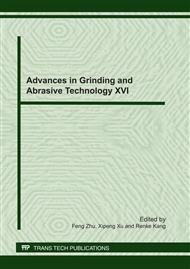p.347
p.352
p.357
p.361
p.366
p.371
p.376
p.381
p.386
Research on Finite Element Simulation and Experiment of Temperature Field in Surface Cutting Used a New PDC Cutter
Abstract:
A new polycrystalline diamond compacts (PDC) cutter was designed and prepared. The new PDC cutter has fibers that are artificially ordered so as to have the desired geometric angles, and it has a larger number of the cutting edges, enough space for holding chips and interrupted cutting so that it is easier to release heat. According to machining properties of materials and working conditions, on the basis of the theory of thermal equilibrium of moving thermal source, the paper established the mathematical model of temperature field of interrupted cutting used the PDC cutter through reasonable hypothesis. Simulations were performed for the temperature distribution in the tool-work interface and inside the Al2O3 ceramic specimen using finite element method. And experiment of surface temperature of Al2O3 ceramic interrupted cutting used the PDC cutter was carried out. The validation and capability of the finite element model were demonstrated by a satisfying agreement between the finite element simulation results and experimental ones.
Info:
Periodical:
Pages:
366-370
Citation:
Online since:
July 2011
Authors:
Price:
Сopyright:
© 2011 Trans Tech Publications Ltd. All Rights Reserved
Share:
Citation:


